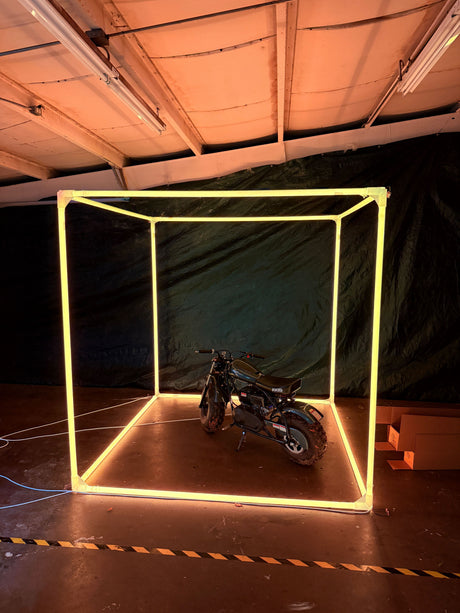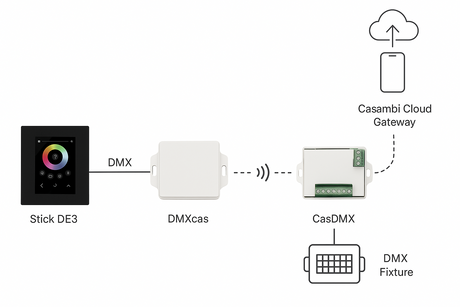Why Color Consistency Matters in LED Lighting
When you walk into a beautifully lit space, you probably do not think about whether every light source is exactly the same shade. But for architects, lighting designers, and installers working on premium projects, color consistency is critical. Small shifts in hue can make an installation look mismatched, reduce the intended visual impact, and even affect the perceived quality of the lighting system. This is where the concept of the MacAdam ellipse becomes essential.
MacAdam ellipses provide a way to measure how closely matched the color output of multiple LEDs is. They help you understand whether two light sources will look identical to the human eye or if subtle differences will be visible. In high-end environments, these differences can make or break the design.
For projects that demand exceptional uniformity, such as hospitality spaces, luxury retail, and architectural installations, we recommend starting with products designed for tight color tolerances, such as our Premium High-Quality LED Strip Light Series. These options ensure that every LED in your installation delivers a consistent tone, maintaining the visual integrity of your design.
What Is a MacAdam Ellipse?
The MacAdam ellipse is named after Dr. David MacAdam, who, in 1942, conducted pioneering experiments on human color perception. His goal was to determine the smallest color difference the average human eye could detect between two light sources. Using carefully controlled visual tests, he found that these thresholds could be represented as ellipses on the CIE 1931 chromaticity diagram, a chart that maps all visible colors.
Each MacAdam ellipse encloses an area where the colors inside are so similar that half of the people would not see any difference between them. This is often referred to as a “just noticeable difference” (JND). The size of the ellipse depends on the region of the color space, ellipses tend to be largest in the green spectrum and smallest in the blue, reflecting how sensitive our eyes are to different wavelengths.
In LED manufacturing, MacAdam ellipses are used to define tolerances in color consistency. The smaller the ellipse step number, the tighter the tolerance. For example, a 2-step MacAdam ellipse represents a very narrow range of acceptable variation, making it ideal for applications where perfect uniformity is required. A 3-step Macadam ellipse allows slightly more variation, which may be acceptable in commercial or outdoor settings where the differences are less noticeable.
When you are choosing LED strip lights for a project, understanding the MacAdam ellipse rating helps you predict how consistent the lighting will look once installed. This measurement takes the guesswork out of evaluating color performance and ensures you get the visual results you expect.
How MacAdam Ellipses Are Measured (SDCM Explained)
In technical terms, a MacAdam ellipse corresponds to a measurement known as Standard Deviation of Color Matching (SDCM). This describes the deviation in chromaticity between an LED’s actual color and a target color point. The smaller the number of SDCM steps, the less deviation there is, and the more uniform the LEDs will appear when viewed side-by-side.
For example:
- 1-step MacAdam ellipse – Virtually imperceptible difference in color to the human eye.
- 2-step MacAdam ellipse – Only highly trained eyes may notice a difference under controlled conditions.
- 3-step Macadam ellipse – Small differences may be visible, but acceptable in most high-quality installations.
- 7-step MacAdam ellipse – More variation, typically used in general illumination, where perfect matching is less critical.
Manufacturers determine these ratings by plotting LED chromaticity coordinates on the CIE diagram and evaluating how closely they cluster around the target point. The ellipse shape represents the range within which 50% of observers would fail to detect any difference.
This is particularly important when ordering LEDs in bulk. Without a defined MacAdam ellipse tolerance, batches can vary enough to produce a patchy appearance once installed. This is why at Wired4Signs USA, we recommend selecting LEDs that specify their MacAdam binning. For example, our LED light panels and premium strips are available with tight binning to maintain color harmony across your entire project.
Real-World Applications of MacAdam Ellipse Standards
In practice, understanding MacAdam ellipses helps you choose the right LED product for your environment. Here’s how it applies to different sectors:
- Architectural Lighting – In high-end projects, a 2-step MacAdam ellipse is often specified to maintain flawless uniformity across large illuminated surfaces.
- Retail and Hospitality – Customers expect a premium look, so a 3-step Macadam ellipse strikes a good balance between consistency and cost-effectiveness.
- Outdoor Signage – Since environmental lighting conditions vary, slightly higher tolerances are acceptable, making 5 to 7-step ellipses a practical choice.
- Stage and Event Lighting – Creative color mixing sometimes makes strict uniformity less critical, so higher step values can be used without affecting visual impact.
One clear advantage of specifying MacAdam ratings is avoiding surprises during installation. Imagine fitting hundreds of LED Light Lines across a hotel lobby, only to see visible differences in hue between sections. By choosing LEDs rated within 2 or 3 MacAdam steps, you minimize the risk of inconsistencies that could compromise your design.
2-Step vs 3-Step MacAdam Ellipse – Which Should You Choose?
The choice between a 2-step MacAdam ellipse and a 3-step MacAdam ellipse often comes down to budget, project requirements, and the type of environment. While both provide excellent color consistency, there are key differences:
- 2-Step MacAdam Ellipse – Delivers extremely tight color tolerances, ideal for luxury applications where even slight differences are unacceptable. This is commonly used in high-end retail, museums, and architectural feature lighting.
- 3-Step Macadam Ellipse – Still offers excellent uniformity, but with a slightly wider tolerance. It’s cost-effective and suitable for most commercial and residential settings where perfect matching is not mission-critical.
For instance, when installing LED strip lights in a luxury boutique, a 2-step MacAdam rating ensures that the entire display glows evenly without any visual distractions. For a home kitchen under-cabinet setup, a 3-step MacAdam rating would likely be indistinguishable to the untrained eye while offering cost savings.
It’s also important to remember that even with tight binning, other installation factors such as driver quality, dimming technology, and heat management can affect perceived color uniformity. This is why pairing your LED strips with a reliable LED power supply is critical for maintaining color stability over time.
Factors That Affect LED Color Consistency
While MacAdam ellipse ratings provide a baseline for expected color uniformity, several real-world factors can still impact performance:
- Manufacturing Variations – Even within a single bin, LEDs can have minute differences due to production tolerances. Selecting products from the same production batch reduces variation.
- Operating Temperature – Heat can shift the color output of LEDs over time. Using LED mounting channels with good heat dissipation can help maintain consistency.
- Driver Quality – Low-quality drivers can cause flicker or color shifts, especially at low dimming levels.
- Voltage Drop – Long runs of LED strips without proper voltage management can result in color inconsistencies. Solutions include amplifiers and shorter wiring sections.
- Environmental Lighting – Ambient light sources can make small differences in LED color appear more or less noticeable.
Understanding these factors allows you to choose the right product and installation method for your application. For outdoor projects, for example, combining a 3-step MacAdam LED with a weatherproof LED diffuser tube can protect against environmental effects while keeping light quality consistent.
How to Verify MacAdam Ellipse Ratings Before You Buy
Before investing in LED lighting, especially for projects where visual uniformity is critical, it’s worth checking the MacAdam ellipse rating. Here’s how to approach it:
- Check Manufacturer Specifications – The product datasheet should clearly list the SDCM or MacAdam ellipse step value. If it’s not included, ask the supplier for clarification.
- Request Photometric Reports – Professional suppliers can provide IES or LM-79 reports showing chromaticity coordinates and binning details.
- Compare Against Industry Benchmarks – High-end architectural lighting typically falls within a 2-step or 3-step MacAdam ellipse, while general lighting may be 4-step or higher.
- Test Samples in Real Conditions – Always test LED samples in the actual installation environment to check for perceived differences before committing to large quantities.
At Wired4Signs USA, we provide transparency on binning and color tolerance for our products, whether you are selecting 3-step MacAdam LED strips or other precision lighting solutions.
Industry Standards and Regulations
MacAdam ellipse ratings are not arbitrary, they are integrated into lighting industry standards to ensure consistency across manufacturers and applications. Some of the key standards include:
- ANSI C78.377 – Defines the chromaticity specifications for solid-state lighting products, with nominal CCT quadrangles that correspond to a 7-step MacAdam ellipse.
- IES LM-79-08 – Specifies electrical and photometric measurement methods for LED products, including chromaticity reporting.
- IEC Standards – International standards that may reference SDCM tolerances for various LED applications.
Understanding these standards can help you navigate product specifications and ensure that you are comparing apples to apples when evaluating different lighting options. If a product meets high-spec LED module requirements with a low-step MacAdam rating, you can be confident in its consistency and suitability for demanding applications.
Final Thoughts
Understanding the MacAdam ellipse standard is essential for anyone who values LED color consistency, whether for retail lighting, architectural projects, or residential use. By paying attention to the step rating, be it a 2-step MacAdam ellipse for precise, high-end applications or a 3-step MacAdam ellipse for reliable general lighting, you can ensure your space looks exactly as intended. Choosing the right LED strip means less guesswork, better visual harmony, and long-term satisfaction with your lighting investment.

























